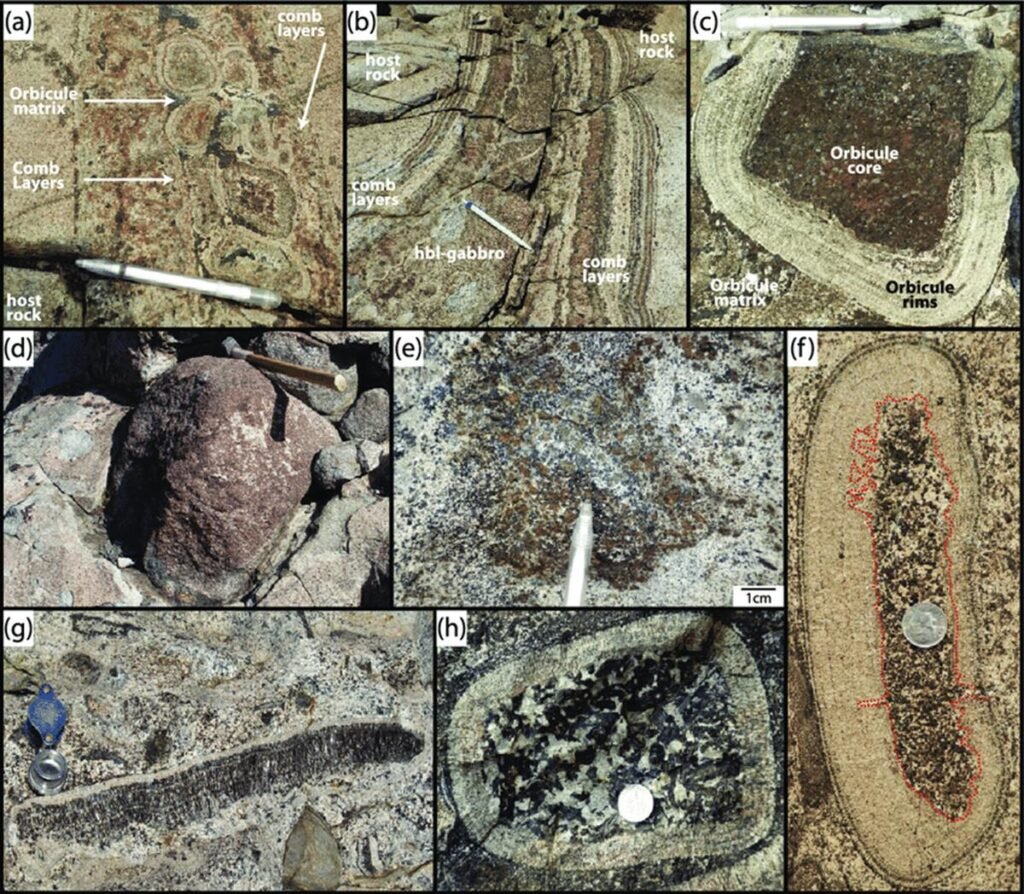Comb layering is an igneous rock texture with long, skeletal to feathery, subparallel crystals oriented perpendicular to a planar boundary, surface, or layering plane.
This texture somewhat resembles the teeth of a comb, hence the name. It is more like long finger-like projections growing inward at right angles from the surface of a dike or intrusion. However, some of these crystals can curve and branch.
Besides branching, these rhythmic bands of elongated crystals can broaden or thicken as they grow inward towards the interior of the plutonic intrusion.
What are they made of? Usually, the elongated crystals are often hornblende or plagioclase. However, others like olivine or augite (clinopyroxene) can grow elongated crystals, too.
Their size is centimeters to meters in thickness and have rhythmic lighter to darker zones, i.e., leucratic to melanocratic zones.
Between comb-like crystal layers, a more granular isotopic textured rock separates them from one another. Isotopic means it has the same properties in all directions.

How does comb layering form?
One condition that favors comb layering is when crystallization happens, where the crystal growth rate exceeds that of nucleation by a significant margin.
It is like nucleation within the melt is at zero, i.e., the inception of a new embryonic crystal from the melt doesn’t happen.
The elongated crystals probably grow on solid particles or substrates at the pluton’s walls, roof, or bottom. This nucleation is called heterogenous. No new nuclei grow like in homogenous nucleation.
A possible explanation for why no new nuclei grow in the melt includes local superheating that purges any formed nuclei.
For instance, if water is abruptly introduced into the melting, superheating will occur as it lowers the liquidus. Liquidous is the temperature above which the melt will entirely be liquid.
Note that it is not possible that the comb layering forms from the crystallization of silicate magma.
Perhaps a large volume of aqueous fluids moving between country rock walls or between the melt and previously crystallized melt interface helps grow this structure.
Comb layering varieties
Varieties connected to specific mineral compositions or occurrences include harrisitic layering, spinifex texture, crescumulate texture, and orbicular fabric.
Harristic resembles comb layering and involves long, comb-like olivine megacrystal aggregates perpendicular to the layering. They rapidly grow after the olivine component saturates the slow-cooling magma.
On the other hand, spinifex texture has acicular olivine phenocrysts. These phenocrysts formed from quick cooling in undercool magma.
What about crescumulate texture? It refers to parallel elongated non-equilibrium crystals of olivine, feldspar, quartz, or pyroxene common in layered mafic plutons and in margins of granites. These crystals nucleate on walls or layer boundaries.
Lastly, orbicular fabric results in the radial development of concentric shells of elongated crystals. Here, the elongated crystals are circular, not straight.
In which rocks does it occur?
Comb layering is typical in plutonic rocks, especially felsic and intermediate. Some of these rocks include diorite, granite, granodiorite, quartz monzonite, monzonite, etc.
For instance, it occurs in the Sierra Nevada batholith in California, USA, in granodiorite, quartz monzonite, and diorite plutons.
References
- Melt Extraction Zones in Shallow Arc Plutons: Insights from Fisher Lake Orbicules (Sierra Nevada, Western USA) – Scientific Figure on ResearchGate. Available from: https://www.researchgate.net/figure/Orbicules-and-comb-layers-within-the-Fisher-Lake-gabbro-diorite-pluton-a_fig6_312020592 [accessed 22 April, 2024]
